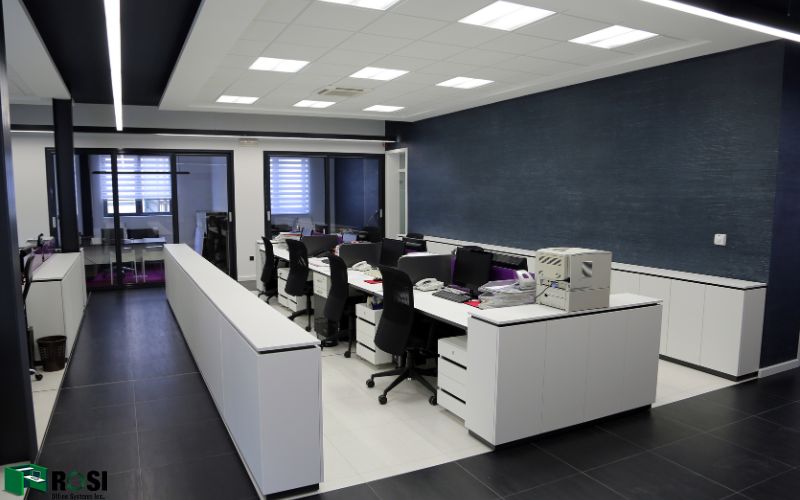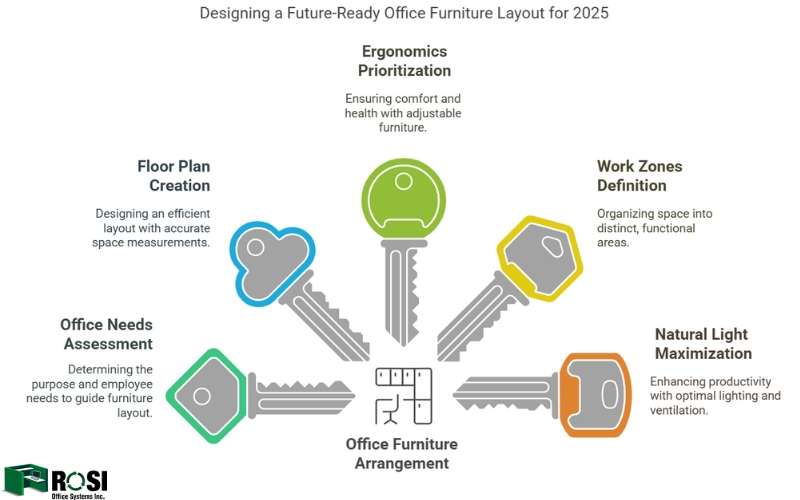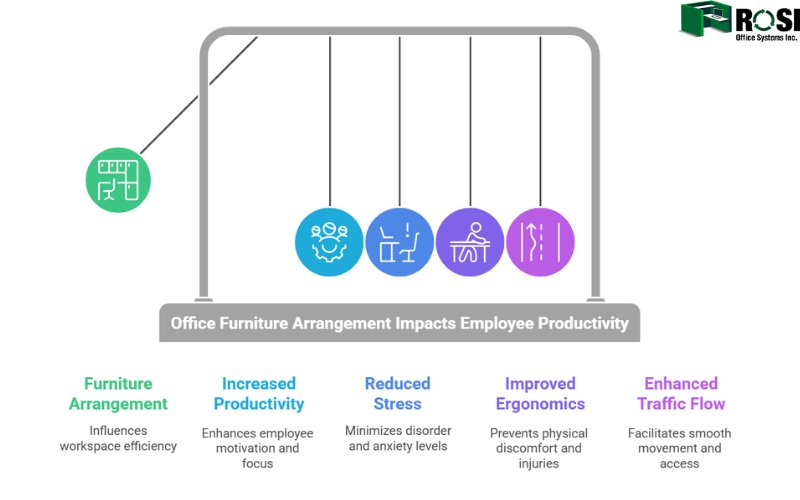
A modern office, where everything is carefully designed and placed, greatly impacts employee productivity and well-being.
In 2025, when businesses are rapidly changing, evolving, and growing, how to arrange office furniture has become more important than ever.
Because the office is no longer just a place to get work done, but a place where a combination of functionality, comfort, and beauty come together.
Office furniture Houston arrangement and the balance between productivity and beauty are some of the important pillars of the success of today’s businesses.
Now, the question is: How do you arrange office furniture? Arrange office furniture in 2025 by prioritizing functionality and flexibility. Optimize layouts to promote collaboration with open desks while maintaining privacy with dividers or acoustic panels. Use ergonomic furniture for comfort and productivity, and position desks near natural light. Incorporate multipurpose furniture to maximize space in modern, dynamic work environments.
let’s check this in more detail!
How To Arrange Office Furniture: 2025 Guide
1. Assess Your Office Needs
Before you do anything, you must determine the main purpose of using the space and the number of employees.
Will you prepare the space for team and collaborative work or individual work?
Or you may need a hybrid space where employees sometimes work collaboratively and sometimes individually.
If you want to create a collaborative space, you need large tables, comfortable chairs, and an open space so employees can easily interact and share their ideas.
If your office arrangement aims to create a space for individual work, you can use smaller tables, ergonomic chairs, dividing walls, or modern office cubicles so that employees can work in a quiet place without distraction.
If your need and choice is to create a hybrid office, you should arrange the layout in a flexible way.
You need adjustable tables and small meeting rooms that can easily be converted into individual and group workspaces.
2. Create a Floor Plan
After assessing the needs, the next step is to accurately measure the space and plan the furniture arrangement correctly.
For this, you can use various software to see a digital map of the office space and the furniture arrangement in a virtual and 3D way.
Ensure that there is enough comfortable and sufficient space for employees to move freely in the arrangement of office furniture.
Also, pay attention to the ergonomics of the work environment and enough space for arm movement, bending, and standing.
The distance between the table and chair, and the height of the tables and chairs should be appropriate. Employees should be able to maintain a correct sitting position.
3. Prioritize Ergonomics
One thing that is necessary to answer how to arrange office furniture is ergonomics.
Ergonomics is the basis of office furniture arrangement in businesses in 2025.
This means choosing furniture that matches the physical characteristics and needs of users to protect the physical health of employees.
Desk heights should be such that people can sit comfortably. So use ergonomic desks that are height-adjustable.
These desks allow employees to change their position from sitting to standing throughout the day to reduce strain on the neck and back.
Ergonomic chairs with adjustable height, backrest angle, and lumbar support are other things to consider.
These features allow employees to adjust the chair to their body’s needs and comfort to prevent potential physical injuries.
In an ergonomic workspace, the location of the monitor is important. The monitor should be at eye level to prevent strain on the neck and eyes.
The distance between the eyes and the monitor should also be between 50 and 70 centimeters.
Therefore, it is better to use adjustable monitors that allow the user to change the angle of the display and its height.
4. Define Work Zones
Another thing to consider when setting up an office is dividing the space into different, usable areas.
Workstations, private office cubicles, storage areas, and rest areas are among the most important of these spaces.
Employees should feel focused and comfortable at their workstations. Storage areas should be designed so that equipment and documents are easily accessible.
In small offices, you can use foldable and multi-purpose desks.
For example, a desk can be converted into a conference table if necessary.
Also, using movable shelves and cabinets is a good idea for storage in small offices.
In these offices, movable panels or walls can be used to make the workspace flexible and quickly divide it into different sections.
5. Maximize Natural Light and Ventilation
Natural light is one of the most important factors to consider when arranging office furniture.
So, place desks in a way that employees receive the right amount of light. Natural light and its amount have a direct impact on people’s productivity and mood.
You can arrange office furniture next to windows or use glass panels to direct light to different parts of the space.
If the light in the space is intense and direct, you can use semi-transparent curtains to prevent intense light and its heat.
You can also use adjustable LED desk lamps with soft light.
When arranging office furniture, also consider proper airflow and ventilation.
6. Promote Collaboration
One of the priorities in arranging office furniture is to consider employee interaction and effective collaboration.
This goal can be achieved by properly arranging desks and chairs and creating a shared workspace.
Setting up group tables and round tables instead of traditional rectangular tables can create a sense of intimacy between people because it makes the space informal and allows employees to interact with each other more easily.
You can also use modular office furniture and small rooms to create group spaces.
Open-concept workspaces are another idea for creating a collaborative workspace.
These spaces, without dividing walls, allow people to easily access each other and speed up the exchange of information.
You Might Also Enjoy: How To Soundproof An Office Cubicle: Top 10 Ideas
7. Choose the Right Furniture
In 2025, office furniture choices will shift towards flexible and sustainable options made from natural and recycled materials.
These changes are driven by a variety of reasons, including the importance of preserving the environment and improving functionality in small spaces.
- Sustainable furniture: Sustainable office furniture that is usually made from natural or recycled materials is a trending style in 2025.
Materials such as wood and recycled plastics have a less negative impact on the environment.
For example, bamboo, which is one of the fastest-growing plants, is a raw material for sustainable office furniture.
Using recycled wood to make desks and other office furniture is also a sustainable choice. Also, using recycled plastics can effectively reduce plastic waste and prevent environmental pollution.
You can use FCS-certified office furniture to furnish your office.
These certificates guarantee that forests are being exploited sustainably and without harming natural ecosystems.
- Modular furniture: To make the most of your workspace, you can use modular office furniture.
This type of furniture is perfect for workspaces that require flexible layouts.
Folding tables and chairs and vertical storage can be very helpful in arranging office furniture that can be quickly transformed into small spaces.
8. Plan for Flexibility and Growth
Since today’s businesses are growing and changing rapidly, you need to consider future changes when arranging office furniture.
Planning for flexibility and growth from the beginning will ensure that your workspace remains functional and efficient as teams expand and priorities change.
As a company grows, the number of employees increases and more space is needed.
For this reason, you should choose office furniture in your office layout that is modular and flexible.
This furniture will help you rearrange your office quickly and without additional costs. Also, consider creating flexible workspaces for team and group activities.
Using multifunctional furniture allows you to easily adjust the space as the size of teams or types of projects changes.
Flexible office furniture design and arrangement allow you to adapt your office space to new priorities without the need for major structural changes.
Therefore, leave enough space between workstations and office cubicles to allow for future expansion.
As the team grows, you’ll be able to add more office furniture without making the office feel cramped.
Flexible and modular office furniture solutions allow you to alter office layouts to meet changing needs easily.
9. Paying Attention to Aesthetics and Branding
The layout of your office furniture and the design of your office are important factors in strengthening and developing your company’s brand.
How to arrange office furniture, what colors you use, and the lighting and materials all have a direct impact on how your brand identity is expressed.
Office design should create a space that is both functional and aesthetically pleasing to your company’s needs.
The colors and style of the furniture should reflect your brand’s values and principles.
The furniture arrangement should be such that visual consistency is maintained throughout the office, as it will have a great impact on the experience of employees and customers.
The harmony between the way office furniture is arranged and the space affects employee productivity and customer interaction.
10. Technology Integration
When arranging office furniture, be sure to include advanced equipment and smart office furniture in the space.
The increasing use of computers, tablets, and other digital gadgets has caused cables to clutter and disorganize the space.
Cable management systems are an effective solution to this problem.
This system allows you to manage space without creating clutter and by keeping cables hidden from view.
You can also use desks with built-in wireless charging pads, smart desks with height adjustment memory, and conference tables with built-in power outlets and USB ports.
Integrated technology and smart office furniture make it easy for employees to access equipment without creating clutter.
Also, when arranging office furniture, place printers, scanners, and other devices in a place that is easily accessible.
Finally, integrating technology into your office design means that you should use cable management systems and charging docks to prevent clutter and position technology equipment in a way that is easy and quick to access while keeping the workspace neat and efficient.
Common Office Arrangement Mistakes to Avoid
How to arrange office furniture While it increases the productivity and motivation of employees, it can easily have a huge negative impact on them if it is inefficient.
Sometimes mistakes are made in the arrangement of office furniture that makes the space unsuitable.
Below, we will discuss some of these common mistakes.
- Cluttering the workspace with extra furniture: Adding unnecessary furniture or accessories only clutters the space and is not effective.
Excessive use of decorative items creates a sense of disorder in the space and consequently stresses employees.
To avoid this problem, use multi-purpose desks, ergonomic chairs, and vertical storage space.
These choices will help you organize your office space effectively and prevent clutter.
- Ignoring ergonomic principles: In a modern office, one should not neglect to observe ergonomic principles.
Choosing appropriate office furniture, height-adjustable desks, and ergonomic chairs with proper backs can create an effective work environment.
Because using non-ergonomic furniture causes problems such as back and neck pain in employees.
- Neglecting the importance of traffic flow: One factor that is sometimes overlooked when arranging office furniture is the lack of consideration for people passing through.
If the arrangement is not done properly, employees’ paths will be blocked or traffic will be created.
Therefore, employees will have difficulty performing their daily tasks.
Creating clear paths for employees to move, and placing furniture in a way that allows easy access to various equipment can help improve traffic flow.
Conclusion
Ultimately, how to arrange office furniture in 2025 can boost employee morale and positive relationships. On the other hand, proper arrangement increases the productivity and comfort of individuals.
Strengthening organizational culture and improving work experience are also results of proper arrangement of office furniture.
Now is the time to think about your workspace and take the first steps to design an ideal environment that suits your individual and organizational needs by contacting ROSI.
Our expert team will provide you with appropriate solutions for selecting and arranging office furniture to create a professional workspace.

John Ofield is a recognized expert in the office furniture and office cubicle industry, with over 40 years of experience. As the founder of ROSI Office Systems, he specializes in space planning, custom cubicle designs, and high-quality commercial furniture. John’s expertise helps businesses enhance productivity and collaboration. He is also dedicated to mentoring entrepreneurs and redefining workspaces to inspire success.





